Marklin SK 800 — Complete Genealogy of a Streamlined Locomotive

No pre-war Marklin locomotive ever lived as long as the Marklin SK 800 streamlined steam locomotive by lasting through WWII to undergo design changes and again flourish as a popular steam locomotive. From its release in 1939 to its slow retreat in 1959 and final reemergence in the 70s, this model was one of Marklin’s most popular and widely sold 00/HO Scale models. During its over 20 years of life, the SK 800 underwent subtle changes that are key in dating the locomotive and determining which versions are rare and which more rare (these are truly the only classifications!). The origins of the locomotive are also quite interesting as the prototype locomotive for the SK 800 was modeled on the class ‘BR 06,’ a 4-8-4 (wheel orientation), and not a 4-6-4 as were Marklin’s prototype and production versions. This change in design is most likely due to practical reasons rather than stylistic ones: a shorter 4-6-4 locomotive would navigate Marklin’s curved tracks better and the basis of the frame with a 4-6-4 wheel arrangement could be reused for other locomotives to save on expensive tooling and production costs. Because of Marklin’s ingenious shortened design of the SK 800, only three parts are really unique to the model: both its locomotive and tender housings and a small truck bracket in the front of the locomotive. Despite its similarities in framework to other locomotives, we’ll soon see that the SK 800 was revolutionary for the 00/HO production line and rode in a class of its own. Let’s start at the beginning — 1939, the year Marklin first introduced the famous SK 800 model.
1939: The Locomotive’s Introduction
We can’t begin to discuss the SK 800 in detail without discussing its origins a little further. The model was almost produced as an SHR 800, 4-6-2, (similar to the earlier O Gauge Marklin model the SLH 66 12920, but the streamlined ash pan beneath the cab was found problematic when the locomotive negotiated curves. The solution was to make it a 4-6-4 model, replacing the large set of two wheels with four smaller rear wheels in the front and back which could easily move underneath the locomotive housing without problems (a small wheel well in the front was added to accommodate the wheels). This takes us to the first SK 800 model from 1939, Version 1, which was introduced in a brilliant olive-green color scheme with black smoke deflectors, golden striping on both the tender and locomotive housings, and typical red-colored wheels. This model, as other subsequent pre-war and some post-war SK 800 models, had seven split-pins securing the upper hand railing wire around the perimeter of the locomotive as opposed to the later models (1946 and onward) which featured only 6 splints. The locomotive’s tender normally features a silver claw coupler whereas the next version of the SK 800 usually has a BK coupler which was introduced in 1939. Both couplers were used simultaneously for a few years. It is also important to note that this model has two small holes with a thick metal wire that runs through both holes above the brush covers. This area above the brush covers is another important way to identify which years an SK 800 was made because some models have this wire, others a brush cover, others lack both, and others have no holes at all. Interestingly enough, the drawings for this version of the SK 800 in the 1939 catalog do show a brush cover on the locomotive while most examples do not have a brush cover until the year 1941. It is hard to say for certain whether the original 1939 SK 800 featured a brush cover or not because the piece is easily removed or added by two metal splints. Often times the outline of the wire can be seen scratched into the paint, but the actual wire and brush cover are missing.
1940: The SK 800 K in Black
The next SK 800, Version 2, was black instead of green and with silver-white striping instead of gold. The SK 800 would remain this black color for a majority of its life with a few exceptions. The model also received an updated model number “SK 800 K” as listed in the 1940 catalog for 00 Scale. The “K” (which would also be put on the box for the locomotive, not as an additional stamp, but as part of the model number) denotes the new coupler design introduced in 1940 (coupler is Kupplung in German). This version also does not have the metal wire running through the two holes above the brushes (nor does it have a brush cover) but most certainly does still have 7 metal pin splints as before. Another special note with regard to coloring and paint is the idea of a brüniert (German for “burnished”) finish which is a kind of chemical finish that sticks very well to metal, protects the metal from corrosion and is much cheaper than traditional paint. It has been commonly discussed that during wartime, Marklin developed this burnished finish because paint was scarce and thus expensive so a chemical coating was used instead. Whether this technique was used as early as 1940 is still up for debate as the level of burnishing is somewhat subjective (it can sometimes look very similar to traditionally applied paint). The model at right, dated approximately 1940, seems to have a burnished finish, but as we’ll see in later models of the SK 800, the burnishing is much more noticeable.
1941 – 1943: Green or Black, You Choose
Perhaps by popular demand, Marklin brought back the brilliant green with gold striping SK 800 locomotive. This year’s release of the model can be differentiated from the 1939 release by both the coupler (this one has a nickel-plated BK coupler instead of a claw coupler) and by the appearance of a green brush cover. The brush cover theory, however, is not recommended as the best way to determine between a 1939 and 1941 green SK 800 because brush covers can easily be removed and added. The best way to tell the difference, of course, would be if the model retains its original box on which a stamp of “9X” would be X quarter of 1939 or “1X” as X quarter of 1941. By this year, unfortunately, the effects of WWII were taking a toll on Marklin’s operations. We can’t even consult the customer catalog of 1941 because one was not issued in that year. We will even find out that later post-war versions of the SK 800 were built from pre-war spare parts and most notably leftover green SK 800 tenders. Were leftover green tenders painted black because Marklin over-produced green SK 800s anticipating a positive response of a re-release of a favorite model or did they under-sell due to the traumatic effects of war? The years 1942 and 1943 are lumped into this time period as they are a definite gray area in Marklin’s operations. Marklin ceased toy manufacturing in the summer of 1943 but it is uncertain whether any new SK 800 models were produced between 1942 – 1943. Surely an SK 800 box stamped with a date stamp of 1943 would solve this mystery, but as evident in post-war years, stamps on SK 800 boxes were very uncommon until 1947. A surplus of these models in the post-war years suggests that it is highly possible, but there is no real certainty without seeing actual production records. A black-painted SK 800 from this time with white lettering “SK 800” to the cab side (only seen in pre-war years) cannot be exactly dated, but shows that locomotives were both painted black and burnished in the pre-war years. It is interesting to compare this SK 800’s paint with the previous black SK 800 featuring a more burnished finish. Note the corrosion and paint chipping to the painted model in contrast to the unblemished burnished model protected by a chemically applied finish.
Red SK 800 and Special Variations
Before we jump the gap between the pre-war and post-war SK 800, it is important to discuss special variations of the SK 800 which appeared in the pre-war years. One such model is an SK 800 locomotive painted in an incredible red color scheme with gold striping similar to that of the green SK 800 models. This specially painted red SK 800 could only be ordered directly from the Marklin factory either by visiting the factory or making a special request through a dealer and was never offered in a customer catalog. A normal production SK 800 would be taken aside to be painted in this special color variation and would be placed in an appropriate box with the stamping rot to the lower right to signify the special red color scheme (rot “red” in German). Only a few such confirmed original models have shown up out of many hundreds of reproduction models which have been made in this highly desirable color scheme. There is speculation that other color schemes exist such as gray-white, blue, and purple for special production and possibly export markets (Portugal has been suggested). These other color schemes are unconfirmed, but seemingly possible even though the only prototypical colors of the BR 06 were green, black, and red.
1945 – 1947: A Post-War Favorite
The SK 800 model again flourished in the post-war years and was most commonly sold in PX-Sets immediately following WWII with the US occupation of Germany. PX stores, or postal exchanges, offered consumer goods to soldiers at discounted prices and many times offered toys that the soldiers could send back to their families at home. The variations of the SK 800s in these sets sometimes changed from month to month. The cars that the SK 800 came with in the SK 851/4 set of the 350s series also changed: lithographed cars in 1945 had tinplate trucks while cars from ’46 and ’47 had die-cast metal trucks. In 1946, cars were hand painted and hand-stamped while in ’47 they were again lithographed. Cars from ’45 and ’46 also had clear plastic window insert while most cars from ’47 had frosted plastic inserts. The changes in these sets go on and on, but we’ll focus our attention on the changes the SK 800 model underwent. In 1945 with the first PX-set for the SK 851/4, the SK 800 model was sold in a red bicycle box with small inscription “SK 800” on the label. This version had either six handrail splints from the new post-war design or seven handrail splints of the pre-war design (most likely leftover stock). Interestingly enough, both of these variants were sold either painted or burnished (bruniert) making a total of four combinations available in 1945. Other differences include a mix of pre-war parts and post-war parts including shiny nickel-plated wheels (pre-war) and unfinished wheels (post-war) from new production. Regardless of the locomotive housing variations in 1945, the tender remained the same across all versions: a green tender with gold striping over-painted in black with white/silver colored striping and a nickel-plated coupler at the tender rear.
In 1946, the design remained relatively similar to new production (with strictly post-war parts) SK 800 locomotives that featured unburnished locomotive housings with six handrail splints. Most versions from 1946 also do not have holes above the brushes for the missing flap, although some versions do exist with these holes present like they were in previous years. The tenders, however, were for the first time sold in a burnished finish alongside black-painted tenders. This change in production technique indicates most likely that the leftover green tenders from the pre-war years had run out and new tenders had to be made. An example of this burnished SK 800 tender comes from a PX-Set in a large brown box dated 1946 by a label on top and 1947 by a sticker on the front. The set’s car boxes have first quarter of 1947 date stamps and the tender and cars all have thin wheels which are typical of 1947. The set, therefore most likely was produced in late 1946 and sold in early 1947. A photo of this interesting burnished tender of early 1947 production can be seen below:
Towards the middle of the 1947 (box stamps indicate 2nd quarter of 1947), Marklin introduced the black-painted SK 800 E (not burnished!) locomotive with hand rails that were cast into the metal as apposed to thin metal wire affixed by splints as seen in previous years.
These new SK 800 models were referenced as “SK 800 E” only on their boxes and featured the additional “E” either before the SK 800 model number or after it. A photo borrowed from EP #6 – Marklin Boxes: Stamps, Labels, and Patterns (Part I) shows the many different SK 800 boxes from 1945 – 1947 and the four different variations denoting the SK 800 E:
The significant redesign of the SK 800 with model SK 800 E shows the high demand for the SK 800 model which was most popular as a set under model number SK 851/4. Most sets were sold in large brown boxes instead of the typical red-boxed sets because inks and dyes were scarce and expensive after the war. Read more about EP #11 – Märklin during World War II. Sets destined for the US-market were stamped with a large “A” and a “110 V” indication on the front while domestic sets staying in Europe had a “D” stamp with a “220 V” stamp. Beginning in 1947, red-boxed sets again appeared and in the United States were sold through dealers and mail order catalogs. The primary US-importer of Marklin during the time, Charles C. Merzbach of Elmhurst, New York, shows the various sets offered in an August 25, 1948 pricelist which was inserted as an update to the 1947 catalog (there was no customer catalog for 1948):
1947 – 1959: Redesigns and the SK 800 N
Already by this time, and undoubtedly with the release of the 1947 catalog D 47, the completely redesigned SK 800 N was introduced. Everything from the wheel linkages which now featured red paint striping to the spoked tender wheels was changed. Some interesting in-between models exist as a cross between an SK 800 E and an SK 800 N, mostly with parts that could easily be interchanged like trailing trucks with spoked wheels and linkages with red painted stripes. Otherwise, the models were very different in design. The new SK 800 N also had either closed brush covers (from 1951 onward) which meant the brushes couldn’t be changed without removing the entire locomotive shell or a brush cover flap not dissimilar to the pre-war design. On the upside, however, the new design featured cleverly placed holes to allow oiling of internal gears and motor components which was very important to smooth operation of the locomotive. Other design changes up to the end of production in 1959 include a “MARKLIN” inscription on the front of the locomotive.
1970s: Comeback as Kit 3907
In the 1970s, the SK 800 was reintroduced as a parts-kit model number 3907 with an SK 800 model similar to the very last one produced in 1959. This kit was sold for two years, 1972 and 1973, and featured a hand switch mechanism that could be triggered by a reversing lever on the right side. Very easy to distinguish from these years is also the appearance of a middle drive with a flange instead of the previous design which featured a middle drive wheel without a flange.

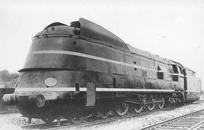

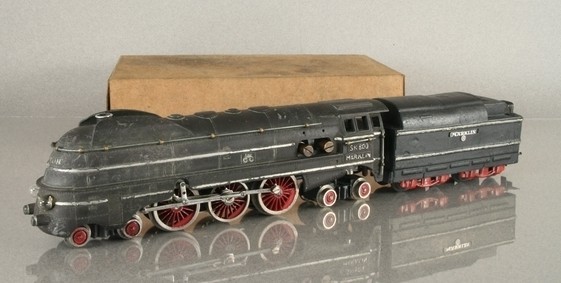
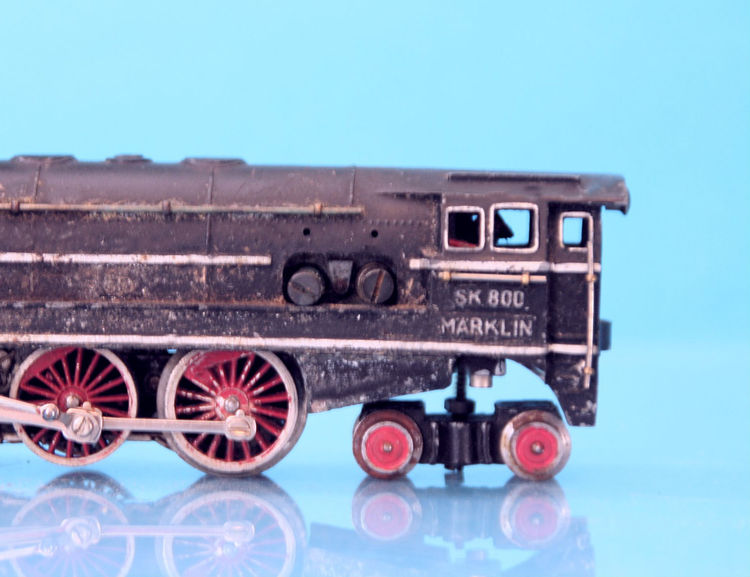
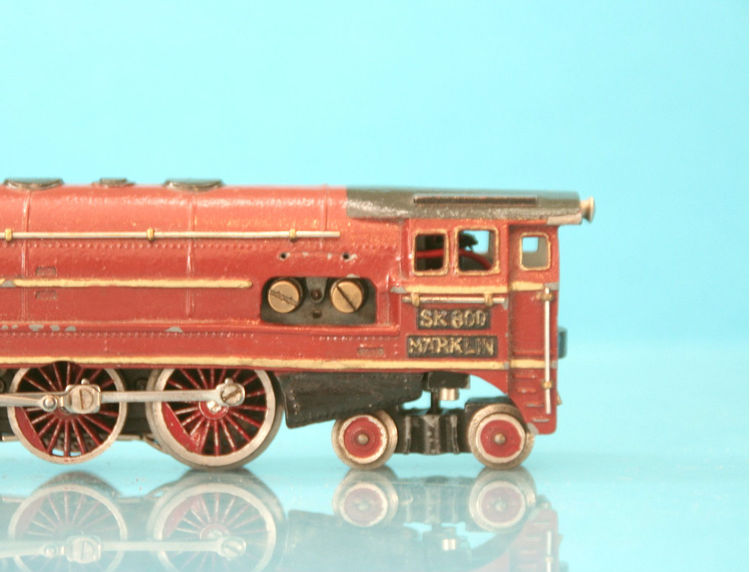
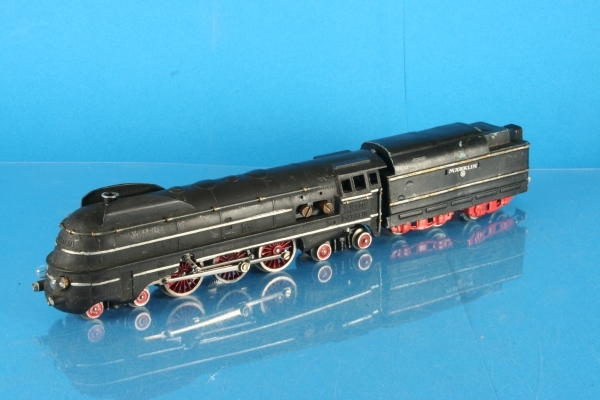
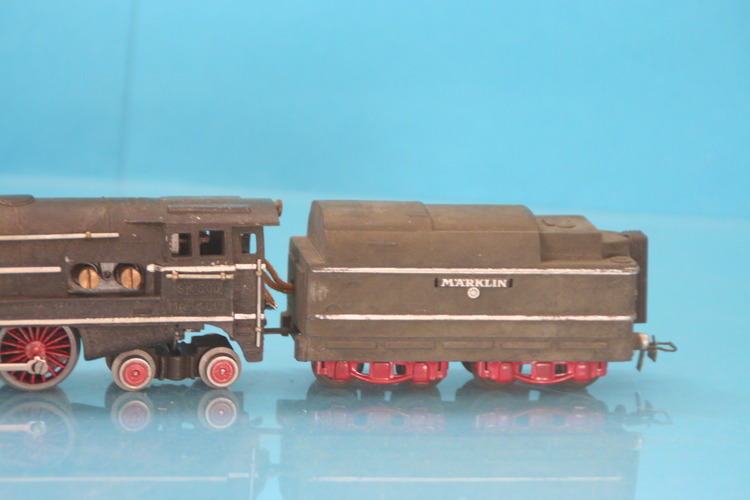
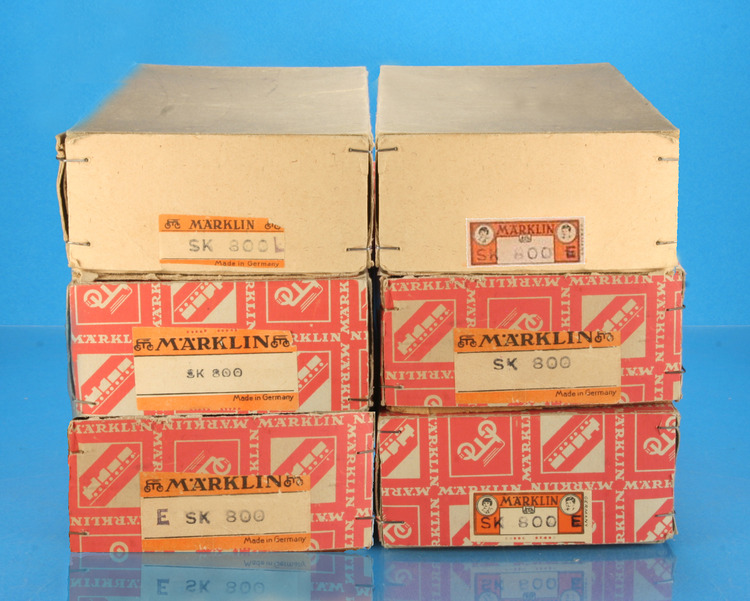
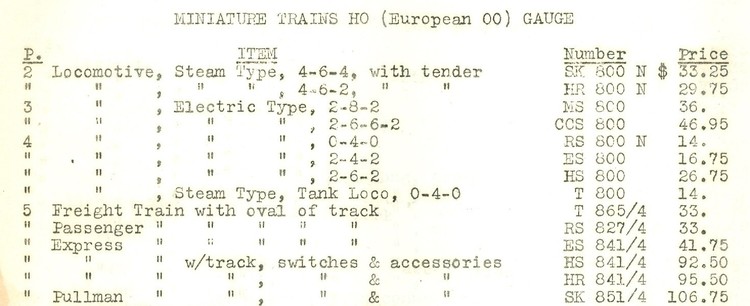
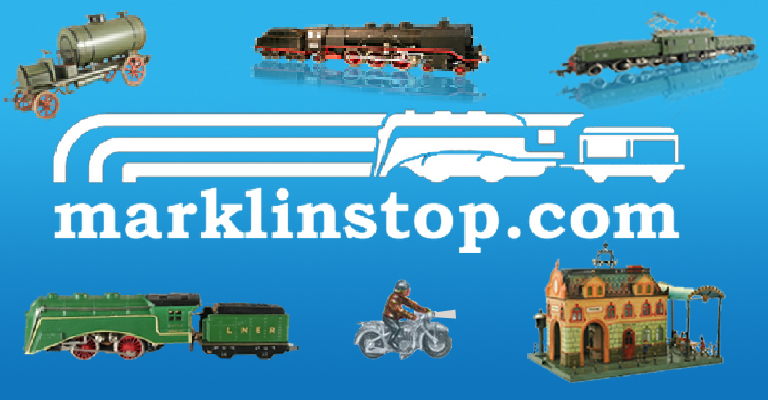
Your genealogy of the SK 800 is most interesting and informative. You may recall that you did an article about Märklin during WW2. I have retired from the ETE EXPRESS having been the editor for the better part of 15 years. Again, good job covering the SK 800.
Cordially
Kurt Miska
Editor – ETE EXPRESS (ret)
Hi Kurt,
Thanks for your compliments. I certainly do remember the ETE Express, was great fun writing the WW2 article. I remember reading some of your contributions there as well.
Best wishes,
Paul
This is the best site I have read for the SK800. I have recently bought one with a tender and (5) passenger cars at an antique store. After reading your information, I believe it was manuf. in 1972 or1973: there are no openings in the Loco shell for brushes and one of the drive wheels has a flange and the handrails are cast. One obvious problem so far is the Loco pickup shoe is damaged. Do you know what Marklin or Other manuf. part no. for the shoe will work? Or better yet, do you have a source for the correct shoe? Thank You! Stan W PS This is the second time I tried to send email to you, the first time I lost it before I could send it. (I have a new Computer with Windows 8.1 and it is giving me headaches.)
Hi Stan, congratulations on your purchases! You’re right, the loco probably is an SK 800 N or the kit 3907. I’m guessing the pick-up shoe is the “double tongue slider” but it could also be the later straight ones. Ritter Restorations in Germany sellers replica parts. You’re probably looking for this piece:
http://ritter-restaurationen.de/item.pl?sprID=1;usrEmail=;usrPwd=;katKey=1.3.9;artID=2478;typ=1
Although sometimes order a single piece from Ritter can be expensive. You’ll probably have better luck on eBay.de searching for “märklin schleifer” and looking for the right one. I believe I have a few spare ones too that might work.
Best,
Paul